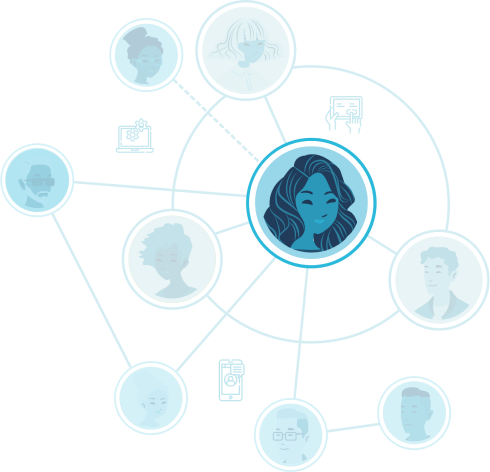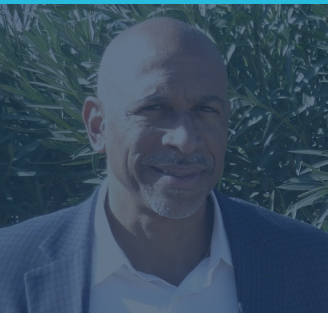Step 1. Take Stock: Getting to Know Who Your Students Know


Guiding questions:
-
How do you currently take stock of the relationships in your students’ lives inside of your school or program? What about beyond school?
-
Who are the people in students’ lives, both inside and outside of school, and what resources—such as support, sense of belonging, and new information and opportunities—are they currently providing?
-
Do students themselves have awareness of the relationships at their disposal and how those relationships could help them accomplish their goals?
-
Reflecting on your current approach to brokering relationships with students, which members of your staff or community do you believe your students feel comfortable reaching out to for support or opportunities? Which relationships could be strengthened or nurtured?

My older brother’s mentor set the path for me and my siblings. A lot of times, that’s the way it works in families: you educate one and then all benefit.”
PEDRO NOGUERA, PH.D., DISTINGUISHED PROFESSOR OF EDUCATION AT THE GRADUATE SCHOOL OF EDUCATION AND INFORMATION STUDIES AT UCLA
Different students will have different needs and interests, and in turn, different sets of relationships. Mapping the relationships students have access to both inside and outside of the classroom can uncover untapped assets for, and overlooked gaps in, their social capital. Institutions committed to getting to know who their students know should measure:
- The number of strong tie and weak tie relationships a student maintains in everyday life
- Where relationships are formed (e.g., school) and with whom
- Students’ awareness of social capital, what it means, and why it matters
-
1
Schools and programs often leave deep reservoirs of social capital, and what researchers call “funds of knowledge,” on the table.
Most schools and programs collect limited information on their students’ networks beyond class rosters, students’ caregivers, or students’ emergency contacts. In other words, students likely have numerous existing, valuable connections in their neighborhoods, faith communities, extended families, or jobs that rarely are connected in a systematic way in support of their educational and career pathways.
-
2
In fact, even students’ existing acquaintances can generate new, expanded opportunities.
When schools and institutions make an effort to understand students’ networks, just asking about their closest friends and mentors won’t tell the whole story. Acquaintances—or what sociologists call “weak ties”—are more likely to contain new information, advice, and opportunities than students’ strongest ties. When taking stock of students’ networks, schools and institutions also should count weak ties.
-
3
Making assumptions about the composition of students' networks based on their demographics can backfire.
Programs designed for entire subgroups can miss critical assets in students’ lives. For example, researchers have found that students from low-income households arrive at college campuses with different social and cultural capital depending on their high school experiences, rather than just their socioeconomic status. Schools and institutions should ask students about their experiences and networks rather than assuming that all members of a given subgroup have the same assets or needs.
Note: Open the PDF to see a complete list of research citations.

Dr. Helen Heinneman and Father Joe Appleyard didn’t just redirect my life—they filled in whole blanks of white space I wasn’t even seeing on the page and colored it in for me.”
Paul LeBlanc, President of Southern New Hampshire University (SNHU)
Asking students about their existing relationships and networks can paint a clearer picture of what relationships students are actually forging in their day-to-day lives, and the different roles those relationships play. The following strategies can help you “take stock” of whom your students know on a regular basis and better leverage those connections over the course of students’ academic and professional journeys:
Click on the green text to see more.
If you’re trying to teach students about the power of networks and social capital → Use relationship mapping to start the conversation from an asset-based perspective:
There’s a simple reason why mapping relationships is a critical first step to investing in students’ networks: visualizing their own network can ensure that students learn about networking through a personal and asset-based lens.
Teaching students about “networking” is often a component of career preparation curriculum and activities. But teaching networking to first-generation students, students from low-income families, and students of color risks devolving into sending the message that their current network isn’t good enough. For example, Opportunity Network operates a six-year college and career program for underrepresented students across New York City to succeed in postsecondary education and careers, starting in high school. For Opportunity Network’s President and CEO AiLun Ku, having students map their networks is aimed at “helping [students] see that their lives are already operating in networks.” A physical drawing of their networks, in Ku’s words, offers a student “a visualization of their existing robust, dynamic networks.” The activity also includes group discussions among students to share with one another how social capital might be exchanged in their existing network, and how somebody might need something and somebody might be able to give it. That exercise is meant to serve as a hypothetical and safe way to explore how social capital is built and exchanged in our everyday lives.
As the curriculum progresses, Opportunity Network not only encourages students to continuously reflect on these assets, but also applies a culturally-responsive lens to discussing networking and social capital: coaches discuss dominant norms around network building and also emphasize to fellows that they have agency in choosing how they build and maintain relationships in school and careers. As Katherine Hanson, Opportunity Network’s Associate Director of Decision Sciences said, “In 11th grade, as they prepare for a speed networking event, a huge amount of students’ time is spent analyzing professionalism.” In this lesson, coaches and students reflect on the ways in which “norms vary by industry, and norms in those industries are determined by those with historical and structural power. Those norms are unspoken but nonetheless rewarded and your reward depends on your personal proximity to historical and structural power.” For Opportunity Network, these reflections offer students agency in how they adapt to different contexts. “Ultimately your goal is not to code switch but to know your desired industry’s norms and then decide how to engage with those professional norms,” said Hanson.
If you’re trying to increase students’ sense of belonging and access to support → Find out who students already trust:
Particularly in light of the pandemic, schools are focused on belonging and support as crucial ingredients to helping students thrive. Instead of assigning support, relationship mapping offers the opportunity to first ask students whom they already feel they can trust or depend on. For example, Making Caring Common (MCC), which offers a relationship mapping strategy, has more recently created and piloted a strategy to collect data from students themselves by having them list all of the adults in school they feel connected to; or, if schools don’t want to collect staff names specifically, they can poll students about the number of adults at school they’d feel comfortable going to if they were having a hard time or facing a personal problem.
In some school communities, MCC has found that it’s important for people to understand what the data is, how it will be used, and what will happen to it after. Moreover, it can be important to frame the exercise to educators as an exercise to build support networks, rather than a popularity contest. “We’ll then plan for action,” said Glenn Manning of Making Caring Common. “We’re saying a student doesn’t have anybody, anyone on staff willing to reach out to her with a show of care and support. Then also consider systemic obstacles to certain kinds of students linking up with adults. They then mark dates for the follow-up for a cohort of adults committed to this work.”
Larger schools and institutions may prefer to move through the process one grade level or department at a time. From there, schools that identify students who lack trusting relationships with adults or faculty can direct additional connections and resources accordingly. For example, watch Ted Dintersmith’s Innovation Playlist to see relationship mapping in action at Jamestown Public Schools.
If you’re trying to increase the likelihood that students mobilize their existing networks → Attach network mapping to personal goals and real-world stakes:
Building a network doesn’t just have to be about students meeting new people; it can be about students having new types of conversations with people they already know. To increase the odds that students will feel motivated to engage with the relationships they identify in their map, relationship mapping should be tied to a goal or opportunity that students care about. For example, at Beyond 12, a college success nonprofit, coaches ask students to identify people they know who can help them tackle real-time challenges they’re grappling with at college. At Big Picture Learning, students are asked to suggest “opportunities” in their existing networks—in the form of prospective internship sites in their communities—that reflect their interests.
In other words, mapping their networks is a chance to reflect on the specific connections that could offer specific types of support or opportunities in service of students’ goals and interests.
That approach has research in its favor. Researcher Brian Lightfoot, who’s studied social capital across schools and nonprofits, has found that authentic social capital-building often comes from connecting “real stakes and purposeful action” to building networks. “There’s a definitive connection between youth voice and putting young people in leadership positions and developing their social capital,” said Lightfoot. By that logic, educators should strive to connect mapping to a goal or context that matters to students, not just to programs’ own goals for students.
If you’re trying to expand students’ professional networks → Start with the employers students and their families already know:
Schools and career centers often look for ways to expand students’ professional networks by inviting guest speakers, mentors, and the like to meet their students. While those new connections can be helpful (see more in Step 3), this approach tends to ignore the professional networks that may already surround students. Most schools approach employer partnerships by either relying on formal partnerships with companies or local chambers of commerce, or leaving educators, counselors, or career offices to nurture their own networks.
Urging students to think across multiple domains of their life can expand the sorts of professional connections they name and activate. For example, at the organizations Social Capital Builders, DeJesus urges young people to think about what he calls “gateway assets” as a way to identify connections beyond their immediate, closest contacts. “By understanding social network analysis, a young person’s developmental connection, like a former coach who works as a warehouse manager, can easily connect the young person to the head of any department within his company. Through quality social network analysis, young people self-discover that those people who they thought were not normally in their network actually are,” DeJesus said.
Another curriculum, Connected Futures, likewise urges students to think in this way: in one of its network-mapping activities, students trace out the chain of connections their networks could unlock. The activity prompts students: ”Put the names of some people you know or are in touch with in the top row. In the row below, list anyone they know who may be able to get you closer to your goal. As you network with each person in the second row, list any other relevant people or resources each person might be able to connect you to in the rows below.”
If you’re working in a resource-scarce, human capital-scarce environment → Use relationship and networking mapping as a student project to identify latent resources:
Not only does relationship mapping provide more detailed information regarding whom your students know and turn to—it can also surface relationships that you could enlist more deliberately to expand supports or opportunities at your institution. Make sure you have a shared contact database where you can store these connections so that they remain within reach for your community to tap into in the future.
-

Beyond 12 coaches college students to reflect on their existing support networks and how to maintain them.
Beyond 12 is a nonprofit that offers virtual coaching to low-income, first-generation, and historically underrepresented students. The Beyond 12 curriculum includes a specific core content area focused on “Networking and Building Social Capital” in an effort to map who plays what roles across students’ networks. As part of this module, students fill in a chart detailing specific relationships in their lives with people who can help them accomplish their goals. They reflect on the help they receive from various individuals; how frequently they interact; how formal or informal their interactions are; and identifying good “next steps” to continue to strengthen those relationships. For more on the Beyond 12 approach, check out our Beyond 12 case study.
Evidence of impact
85% of students whom Beyond 12 has coached for four years have either graduated or are still enrolled in college.
Sample data collection strategy
Beyond 12 coaches use a checklist to identify the extent to which students are growing their on-campus networks.
- Identify a campus advocate or mentor
- Identify three peers who can serve as references
- Create at least one study group with high-performing peers
-

Big Picture Learning asks students about their existing networks to generate and distribute local internship opportunities.
Big Picture Learning, a national nonprofit that supports internship-based learning high schools, has designed a technology tool called ImBlaze to help schools manage work-based learning contacts and opportunities. But schools don’t just use ImBlaze as a productivity tool; at the start of their semester, Big Picture students are encouraged to upload their existing and new contacts that they have in local businesses through their families, communities, and other networks. From there, students across the school have visibility into the range of opportunities represented across their entire school community—not just limited to their existing, inherited networks. The tool also provides references and records on students’ previous experiences at various internship sites.
Evidence of impact
95% of Big Picture Learning students were accepted into two-year or four-year institutions. 88% of those who did not enroll in college secured full-time employment—with 74% reporting that this employment was facilitated through a mentor or contact from one of their internships.
Sample data collection strategy
Some Big Picture schools administer surveys to students at regular intervals that ask questions such as:
- What adults do you plan to work with today [in your internship]?
- How connected do you feel to the adults you are working with at your internship right now?
What relationships does your school or program deliberately put within reach and emphasize already? What checks and balances are in place to ensure that all students—rather than only those who are the most outgoing—are forging relationships?
Download our guided worksheet to keep track of your progress while going through the playbook.
Customize a plan-
Search Institute’s Relationships Check Tool
This free survey can be used for self-reflection to see where young people’s relationships with educators and staff are particularly strong, and where they can grow. When it’s complete, you’ll receive actionable approaches and activities to strengthen relationships with young people.
-
Making Caring Common’s Virtual Relationship Mapping Strategy
This free tool helps educators and administrators identify perceived positive and stable staff-to-student relationships so they can visualize trends within the school community. Tools for peer-to-peer and staff-to-staff relationship mapping are currently in production.
-
RESCHOOL Colorado’s Learning Map
This free protocol offers guidance for mapping the people, places, and tools involved in student learning.
-
Connect Our Kids’ Family Connections Tool
This tool is free for social workers serving young people in the foster care system. It maps existing and extended family connections and other supports in a young person’s life.
-
Visible Network Labs’ PARTNER Platform
This paid management system and app tracks network size and strength at the individual and organizational level. PARTNERme is a mobile social needs screening and referral tool. It uses network science to make social support and resource networks visible to enable whole-person care.
-
Loom’s Salesforce Map your relationships tool
This paid Salesforce extension application allows users to map and analyze social network connections across their contacts.
-
Big Picture Learning’s ImBlaze internship management tool
This tool is a paid platform for uploading and coordinating internship opportunities.
-
CERES Institute’s Using Webs of Support Framework
This free tool offers a process and script for educators to engage students in relationship mapping.
-
Network Canvas
This free tool is an open source software for collecting and analyzing social network data built by and for researchers.
-
Connected Futures
This free curriculum is an evidence-based approach to teaching students about building and maintaining their networks.
-
nXu
This curriculum helps students to explore their purpose in the context of their community, along with embedded social capital measures.
